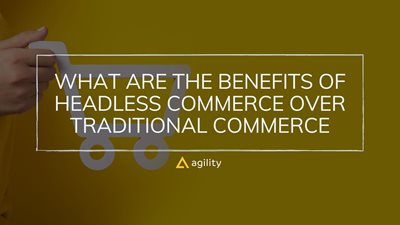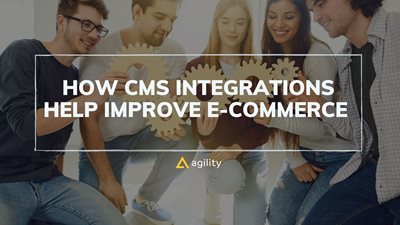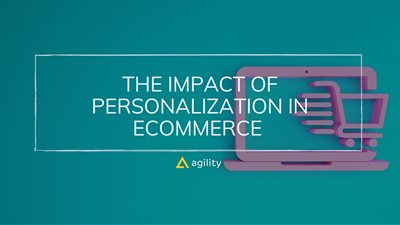What are the Benefits of Headless Commerce Over Traditional Commerce
In the world of e-commerce, there are two distinct types of commerce platforms: traditional and headless. Which one is right for you?


In e-commerce, there are two distinct types of commerce platforms: traditional and headless. Traditional commerce is what you might know as having an online shopping cart that takes customers from the front end product page when choosing products and then moves them to the backend on checkout.
On the other hand, Headless commerce doesn't have such a shopping cart. Instead, it relies on 3rd party integrations to handle transactions in real-time when a customer chooses a product. For many businesses, this makes sense because they don't want their data out in the open or locked into one system.
But how does this work, and what are some benefits?
Let's answer those questions below.
Flexibility and Personalization of headless commerce
A headless commerce platform will take a customer's order and put it through the appropriate API (like Shopify) to debit their credit card and send that customer an email confirmation with tracking numbers, all without ever having any of your data in-house.
The benefit of this is the flexibility for you as a business owner so you can keep up with market trends or offer new products without needing to overhaul your system.
It also means more personalized service because when building out integrations, there are many opportunities for customization - you don't have to rely on one company's vision if what they're providing isn't working best for your needs.
This also means a more seamless experience for the customer. Instead of going back and forth between your site and another, they can enter their purchase information on one website. There are many ways to impress your customers during their visit to your website, and going headless is one of them.
In addition, headless commerce is much more flexible if you need to change how it functions - traditional commerce often has specific requirements that must be met.
A headless platform also means no upfront cost or commitment of any kind because, with this type of eCommerce, there's nothing set up for you - however, you must also know what you need from your system at the very beginning.
This allows developers to create something custom for your business without worrying about future expenses or additional integration work.
Benefits of Headless Commerce Over Traditional Commerce
Let's look at the various benefits that headless commerce offers over the traditional model.
1. Adding new products or offers
Adding new products and offers is one of the most compelling reasons to go headless.
A new product may require additional integration work, which may be difficult for your company because you're tied into an old system and don't want to invest in a new one just yet.
Headless commerce solves this problem by letting you integrate with whatever structure best suits your business needs at any given time.
This means that no matter what offer you are presenting to your customers, the technology will be there to help you keep your sales flowing at any given time.
A flexible platform is more straightforward (compared to having to change your processes around what has already been built) and more secure, which means there are fewer opportunities for something going wrong when updating or adding features.
Another reason flexibility might make sense is if your current (traditional) way of operating isn't working well for your specific needs - or if this solution is not providing what you need.
Headless commerce also means more personalized customer service because, with this type of e-commerce, there are many opportunities for customization - you don't have to rely on one company's vision if the integration is not meeting your needs.
2. Offering a more personalized service
You can offer a more personalized service to your customers because you have many customization opportunities when building out integrations to meet your needs best. More customized service means you can offer your customers the best experience possible - something that's not guaranteed with traditional commerce.
In practical terms, Personalization could mean that your site offers a customer service chatbot platform that solves their problem and lets them know about discounts, promotions, and new products.
It also means better communication because you can customize the integration to suit your needs with headless commerce. For example, if an API is providing inaccurate data or doesn't provide what you need, it's easier for you to change how it functions. In contrast, traditional e-commerce often has specific requirements that must be met.
Headless platforms are much more flexible than other types of solutions, giving developers opportunities without upfront costs or commitment. This allows developers to create something custom for your business without worrying about future expenses or additional integration work later on.
With a headless platform, you could go in whichever direction you wanted to, from creating your online course platform to developing a specific tool that would be valuable to your customers.
3. Seamless experience for customers
It's frustrating for a customer to go multiple places to complete a transaction.
Having customers stay on one website to complete a transaction means they will be much more likely to achieve it - meaning they'll spend less time going back and forth between websites.
This is also great for your bottom line because you can sell more products with fewer visitors. It's not hard to see that this could increase revenue.
You're getting better results out of fewer people, so if, typically, people purchase higher ticket items, then a headless commerce integration would work best. This will allow you to offer a better experience since these customers need personal attention and assistance throughout their shopping experience.
The more focused the customer experience is, the more likely they'll be to get what they want and not leave the site without completing their transaction.
Learn more: How to Simplify your Customer Experience (CX) for Success?
4. Tailoring the initial cost according to your needs
Flexibility allows developers to create integrations explicitly customized around the business needs without worries about future expenses like other types of solutions might require.
Due to the flexibility offered by headless commerce, developers can create integrations that also have the opportunity to be customized around your needs.
The cost requirements for a headless solution differ from a standard key because they are only required to provide the service and any data or services you might need. That said, developers must know what their customers need, so there is no waste on either side.
Usually, by providing developers with a clear idea of what is required on your side, they can put together a much more accurate and competitive quote.
5. Security benefits
Security is always a big concern when dealing with a commerce solution. Customer information is always susceptible to ending up in the wrong hands unless suitable measures are taken.
With a headless commerce integration, all customer information is securely stored within the platform so that it's not out in the open or accessible to unauthorized personnel - eliminating any threat of data breaches.
The integrations can also be customized, and you can control what type of access an API has when interacting with your site, as well as how much contact there is between them on both ends.
This way if anything were to happen - for example, someone hacked into your website and was trying to sell products they didn't have permission for - then they would only get minimal knowledge about what needs changing rather than taking over the whole system like could potentially happen with traditional e-commerce sites.
It means less operational costs, faster customer response times, and more efficient with your actions.
6. Seamless integration with various other services
When going headless, it's easier to integrate with other services like social media, email marketing campaigns, and more.
This is because headless commerce solutions are API-based, so developers have a lot of flexibility to do whatever they want. Most importantly, the customer experience is not hampered in any way.
In the traditional sense, integration has always been a one size fits all type of solution, meaning it had many more limitations but also came at much higher price tags. This usually meant committing upfront without having access to other options available if there was another issue down the road.
With headless eCommerce integrations, however, developers can work with you from the start and have much more freedom.
Consider the complexity of the headless eCommerce platform
It is essential to consider the complexity of the platform when deciding which type of model is right for your business.
If you're a smaller company, headless commerce might not be as feasible since it might require more work upfront to set up an API or website connection than traditional e-commerce sites do.
This means that developers would have to create integrations from scratch rather than being able to simply plugin with another service like they can with other types of solutions.
However, suppose you already were using platforms such as WordPress or Drupal. In that case, it's worth considering going headless because integrating those services is much easier and quicker due to their familiarity.
There are even plugins available designed primarily for use in these cases, so it might even be the case that there's no need for developers to start from scratch.
Headless commerce can be worth it if you're a larger enterprise because of the lower operational costs and easier integration with other services.
Just make sure that your developers know what is required on your end before they provide quotes, so there's no waste in either direction.
Preparing to go with headless commerce
If you're considering switching from traditional to headless commerce, there are a few things to consider before you do.
1. First of all, it's essential to get the opinions of your stakeholders, customers and partners on what they feel would be best for them.
This way, everyone has their say in how something is set up or configured, leading to better results. If there are discrepancies, try to find common ground so that all parties will be happy with the integration.
2. Next, make sure that the chosen developers have experience working in this field because if they don't know what they're doing, it could take much more time than necessary - or even not work.
Be wary of anyone who says they'll handle everything without giving many details, too, as this may end badly - given the complexity behind headless commerce.
3. Lastly, ensure you're willing to risk not having a traditional platform for it to be worth your time and resources. There are many reasons this can be beneficial, but there's no point if you don't have faith in what could happen down the road.
It might sound like a good idea at first glance but keep all possibilities open before making any decisions - or else ask someone who knows more about headless eCommerce than its surface-level benefits.
Conclusion
Going with a headless commerce model is not for everyone, but it comes with its own benefits - which is why it might be worth considering, given your goals and needs.
Ensure that you understand what is involved before making any decisions, though - or else you might regret it later.
With that said, considering the various benefits mentioned in this article, there are many reasons to switch from traditional e-commerce to a headless commerce platform.

About the Author
Ecommerce Blogs For You

How CMS integrations help improve your Ecommerce site

The Impact of Personalization in Ecommerce
1+1 > 2: Agility CMS plus your Ecommerce platform can do more together
Building an ecommerce solution with Agility means you get more than just ecommerce; you get the power to promote and deliver the most relevant content to drive your online revenue.
Learn More
